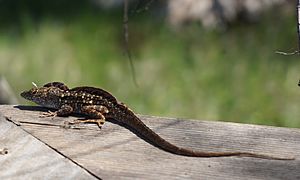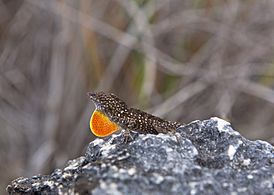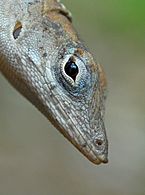Brown anole facts for kids
Quick facts for kids Brown anole |
|
|---|---|
 |
|
| Male displaying dewlap | |
| Conservation status | |
| Scientific classification | |
| Genus: |
Anolis
|
| Species: |
sagrei
|
| Synonyms | |
|
|
The brown anole (Anolis sagrei), also known commonly as the Bahaman anole or De la Sagra's anole, is a species of lizard in the family Dactyloidae. The species is native to Cuba and the Bahamas. It has been widely introduced elsewhere, by being sold as a pet lizard, and is now found in Florida and as far north in the United States as southern Georgia, Texas, Louisiana, Mississippi, Alabama, Hawaii, and Southern California. It has also been introduced to other Caribbean islands and Taiwan in Asia.
This species is highly invasive. In its introduced range, it reaches exceptionally high population densities, is capable of expanding its range very quickly, and both outcompetes and consumes many species of native lizards. The brown anole's introduction into the United States in the early 1970s has altered the behavior and negatively affected populations of the native Carolina anole (Anolis carolinensis, also known as the green anole), which have since generally been relegated to the treetops.
Etymology
The specific name, sagrei, is in honor of Spanish botanist Ramón de la Sagra.
Description
The brown anole is normally a light brown color with darker brown to black markings on its back, and several tan to light color lines on its sides. Like other anoles, it can change color, in this case a darker brown to black. Its dewlap ranges from yellow to orange-red. The males can grow as large as their male Carolina anole counterparts, around 17.8–20.3 cm (7.0–8.0 in) long, with some individuals topping 22.9 cm (9.0 in). The females are also around the size of female Carolina anoles: 7.6–15 cm (3.0–5.9 in). The male brown anole's head is smaller than that of the male Carolina anole. Also, the brown anole's tail has a ridge that travels all the way up to behind the head, a feature that the Carolina anole lacks. Female brown anoles can be distinguished by a light brown stripe that runs over their back, a feature that males lack.
-
Florida female
-
Grand Cayman juvenile
-
Male extending his dewlap in Citrus County, Florida
Life cycle
Brown anoles live on average 4–5 years in the wild but have been known to survive up to 8 years in captivity, though reaching this age is uncommon. They reach sexual maturity one year after hatching, and typically breed in the summer months (depending on the climate) from March-April to August-September. After breeding, the female will lay 1–2 eggs every 7–14 days, burying and then abandoning them. If viable, the eggs will hatch about seven weeks later, and the hatchlings that survive do so entirely on instinct.
Shedding
Brown anoles molt in small pieces, unlike some other reptiles, which molt in one large piece. Anoles may consume the molted skin to replenish supplies of calcium. In captivity, the molted skin may stick to the anole if humidity is too low. The unshed layer of skin can build up around the eyes, preventing the lizard from feeding and may lead to starvation. This can be prevented by maintaining high humidity.
Diet
Brown anoles feed on small arthropods such as crickets, moths, ants, grasshoppers, cockroaches, mealworms, spiders, and waxworms. They may also eat other lizards, such as skinks and the Carolina anole, lizard eggs, and their own molted skin and detached tails. If near water, they eat aquatic arthropods or small fish – nearly anything that will fit in their mouths.

Predation
As a defense mechanism, the brown anole can detach most of its tail when pursued or captured (autotomic). The piece that breaks off will continue to move, possibly distracting the predator and allowing the anole to escape. The lost tail will partially regrow. If provoked, the brown anole will bite, urinate, and defecate. Also some brown anoles may do a short hiss if caught, injured, or fighting. Predators include rats, snakes, birds and many larger animals such as cats.
Recent work in experimentally introduced populations in the Bahamas has shown that body size in the brown anole may not be affected by predation, as was previously thought.
Communication
Anoles use visual cues as their primary signaling mode.
- Kolbe, J. J., Larson, A., & Losos, J. B. (2007). Differential admixture shapes morphological variation among invasive populations of the lizard Anolis sagrei. Molecular Ecology, 16(8), 1579–1591. doi: 10.1111/j.1365-294x.2006.03135.x
- Hargrove, J. (2019, July 11). Cuban anoles at war with native Carolinians. Aprachicola & Carrabelle: The Times.
- Iracheta, Michelle. "Researchers Ask for Help in Documenting Spread of Invasive Lizard." Houston Chronicle, 14 May 2018, www.chron.com/neighborhood/woodlands/news/article/Researchers-ask-for-help-in-documenting-spread-of-12913485.php.
- Calsbeek, Ryan. "Sex‐specific adult dispersal and its selective consequences in the brown anole, Anolis sagrei." Journal of Animal Ecology, vol. 78, no. 3, 31 Mar. 2009.
- Rachel M Moon, Ambika Kamath. "Re-examining escape behaviour and habitat use as correlates of dorsal pattern variation in female brown anole lizards, Anolis sagrei (Squamata: Dactyloidae)." Biological Journal of the Linnean Society, Volume 126, Issue 4, April 2019, Pages 783–795, https://doi.org/10.1093/biolinnean/blz006
- Salzburg, Mark A. “Anolis Sagrei and Anolis Cristatellus in Southern Florida: A Case Study in Interspecific Competition.” Ecology, vol. 65, no. 1, 1 Feb. 1984, pp. 14–19., doi:10.2307/1939453.
- Losos, J. B., Creer D. A., Glossip, D., Goellner, R., Hampton, A., Roberts G., Haskell, N., Taylor, P. & Jeff Ettling (2007). Evolutionary implicstions of phenotypic plasticity in the hind limb of the lizard Anolis sagrei. https://doi.org/10.1111/j.0014-3820.2000.tb00032.x
See also
 In Spanish: Anolis sagrei para niños
In Spanish: Anolis sagrei para niños







